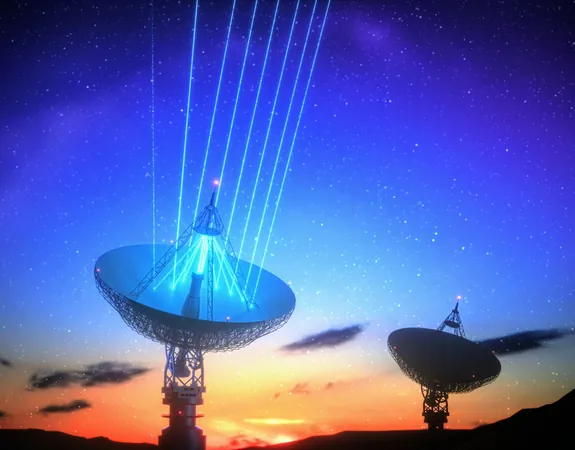
Astonishing Discovery: Radio Burst Signals Emanate from a 'Dead Galaxy'
2025-01-23
Author: Ying
Introduction
In an extraordinary twist of cosmic exploration, astronomers have detected a fast radio burst (FRB) emanating from a region of space that challenges existing scientific theories. Fast radio bursts are brief and intense flashes of radio waves, typically lasting just a few milliseconds. Since their first detection in 2007, over a thousand such bursts have been tracked, yet their origins remain largely enigmatic.
The Discovery
In a captivating recent case, researchers focused on a series of repeated bursts originating from the northern constellation of Ursa Minor. This particular signal caught the attention of astronomers due to its unique characteristics, suggesting it was located far beyond the familiar boundaries of our Milky Way galaxy.
With the aid of advanced radio telescopes, including a newly commissioned device capable of integrating signals from multiple arrays, scientists were able to determine that these bursts originated from the outskirts of an ancient elliptical galaxy located approximately 2 billion light-years from Earth. This faraway galaxy, which is estimated to be around 11.3 billion years old, raises significant questions among astronomers. Typically, such an old galaxy would be devoid of the active stellar environments necessary for creating the young, magnetized neutron stars known to generate fast radio bursts.
Scientific Implications
Astronomer Calvin Leung from the University of California, Berkeley, highlighted the mystery: 'How can there be a magnetar, a baby neutron star, located in what we assume to be a dead galaxy?' This unexpected find compelled researchers to direct optical telescopes towards the galaxy, revealing an astonishing truth—a long-dead galaxy absent of the active star formation hubs generally believed to produce such celestial phenomena.
Vishwangi Shah, a graduate researcher at McGill University, underscored the significance of this discovery, noting that not only is this the first FRB found outside a dead galaxy, but it is also the farthest from its associated galaxy compared to all recorded FRBs. Shah's study on this unusual burst, designated as FRB 20240209A, was recently published in the Astrophysical Journal Letters.
Technological Advancements
The Canadian Hydrogen Intensity Mapping Experiment (CHIME) — a major player in detecting these bursts — has begun using newly installed outriggers to improve its imaging capabilities, with hopes of locating one FRB per day. This surge in precision allows for simultaneous observations using both optical and infrared telescopes, which can reveal whether these bursts originate from dense star clusters or distinct structures situated within a galaxy.
Broader Understanding of FRBs
The implications of this discovery are profound, suggesting that the environments where FRBs occur are far more diverse than previously understood. The consensus amongst researchers is that the phenomena linked to fast radio bursts are not merely confined to star-forming galaxies; there may be globular clusters of ancient, dead stars contributing to the creation of these energetic signals. If confirmed, this would mean FRB 20240209A is only the second recorded fast radio burst connected with a globular cluster.
Conclusion
This groundbreaking research has ignited new questions about the lifecycle and evolution of galaxies, as well as the nature of magnetars themselves—objects believed to only arise in young, vibrant stellar environments. With all of this data at hand, astronomers are keen to unveil the enigmatic forces behind these bursts and what they reveal about the universe's history.
While scientists are navigating through this newfound mystery, they recognize that addressing these questions might lead to even more staggering revelations. The ongoing collaboration of telescopes and innovative technology could soon unravel the secrets of the cosmos hidden among the stars.
In conclusion, the discovery of an FRB originating from a 'dead galaxy' is not just a remarkable scientific milestone; it's a stepping stone toward unlocking the mysteries of our universe, inviting both awe and profound curiosity about the forces at play in the vast cosmos beyond our own planet. Stay tuned, as the universe continues to surprise us with its secrets!



 Brasil (PT)
Brasil (PT)
 Canada (EN)
Canada (EN)
 Chile (ES)
Chile (ES)
 Česko (CS)
Česko (CS)
 대한민국 (KO)
대한민국 (KO)
 España (ES)
España (ES)
 France (FR)
France (FR)
 Hong Kong (EN)
Hong Kong (EN)
 Italia (IT)
Italia (IT)
 日本 (JA)
日本 (JA)
 Magyarország (HU)
Magyarország (HU)
 Norge (NO)
Norge (NO)
 Polska (PL)
Polska (PL)
 Schweiz (DE)
Schweiz (DE)
 Singapore (EN)
Singapore (EN)
 Sverige (SV)
Sverige (SV)
 Suomi (FI)
Suomi (FI)
 Türkiye (TR)
Türkiye (TR)
 الإمارات العربية المتحدة (AR)
الإمارات العربية المتحدة (AR)